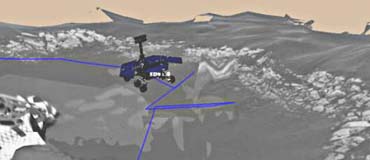| . |  |
. |
MER engineers at JPL are using a graphical planning tool to plot and scheme the perfect location to place the rock abrasion tool on the rock collection dubbed "El Capitan" near Opportunity's landing site. "El Capitan" is located within a larger outcrop nicknamed "Opportunity Ledge." The rover visualization team from NASA Ames Research Center, Moffett Field, Calif., initiated the graphics by putting two panoramic camera images of the "El Capitan" area into their three-dimensional model. The rock abrasion tool team from Honeybee Robotics then used the visualization tool to help target and orient their instrument on the safest and most scientifically interesting locations.
 The blue circle represents one of two current targets of interest, chosen because of its size, lack of dust, and most of all its distinct and intriguing geologic features. The rock abrasion tool is sensitive to the shape and texture of a rock, and must safely sit within the "footprint" indicated by the blue circles. The rock area must be large enough to fit the contact sensor and grounding mechanism within the area of the outer blue circle, and the rock must be smooth enough to get an even grind within the abrasion area of the inner blue circle. If the rock abrasion tool were not grounded by its support mechanism or if the surface were uneven, it could "run away" from its target. The rock abrasion tool is location on the rover's instrument deployment device, or arm. Over the next few martian days, or sols, the rover team will use these and newer, similar graphics created with more recent, higher-resolution panoramic camera images and super-spectral data from the miniature thermal emission spectrometer. These data will be used to pick the best spots to apply the rock abrasion tool on two very distinct areas of "El Capitan." The upper and lower portions of "El Capitan" have different textures, and both areas should provide distinct and unique clues about the history of Mars. The rock abrasion tool will also enter the target areas from different perspectives, creating unique views simply by the way they grind into the different areas of the rocks. For the current upper target (seen here), the rock abrasion tool would go into the rock as if from the side of a layered cake, while at the bottom target, the instrument would enter from above as if going down the middle of a cake. "El Capitan" was named after a mountain in Texas, but on Mars, it is about 10 centimeters (4 inches) high. Scientists are eager to use the rock abrasion tool to peer deeper into the history of the formation of "El Capitan," and the team will spend multiple sols taking pre- and post-measurements of the rock targets. Opportunity will spend one sol moving inbetween target locations. Based on a JPL and AstroBiology Magazine report Related Links Mars Rovers at JPL Mars Rovers at Cornell SpaceDaily Search SpaceDaily Subscribe To SpaceDaily Express  Pasadena - Feb 20, 2004
Pasadena - Feb 20, 2004By inspecting the sides and floor of a hole it dug on Mars, NASA's Opportunity rover is finding some things it did not see beforehand, including round pebbles that are shiny and soil so fine-grained that the rover's microscope can't make out individual particles.
|
| ||||||||||
| The content herein, unless otherwise known to be public domain, are Copyright 1995-2016 - Space Media Network. All websites are published in Australia and are solely subject to Australian law and governed by Fair Use principals for news reporting and research purposes. AFP, UPI and IANS news wire stories are copyright Agence France-Presse, United Press International and Indo-Asia News Service. ESA news reports are copyright European Space Agency. All NASA sourced material is public domain. Additional copyrights may apply in whole or part to other bona fide parties. Advertising does not imply endorsement, agreement or approval of any opinions, statements or information provided by Space Media Network on any Web page published or hosted by Space Media Network. Privacy Statement All images and articles appearing on Space Media Network have been edited or digitally altered in some way. Any requests to remove copyright material will be acted upon in a timely and appropriate manner. Any attempt to extort money from Space Media Network will be ignored and reported to Australian Law Enforcement Agencies as a potential case of financial fraud involving the use of a telephonic carriage device or postal service. |